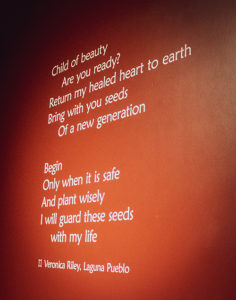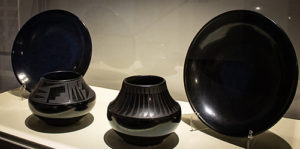![]() Indian Pueblo Cultural Center—Albuquerque New Mexico
Indian Pueblo Cultural Center—Albuquerque New Mexico
One look at the IPCC website, https://indianpueblo.org/ and you’ll already have an idea of what to expect during a visit. However, along with the obvious attributes of any fine museum and cultural center, this place exudes personal stories, artworks, cultural histories, and a vibe that is difficult to explain—intuitive in nature, with a splash of solidarity among peoples.
The Pueblo People are as similar and diverse as the lands they inhabit—rugged, beautiful, and most importantly spiritual in nature. As the earth changes and folks are once again migrating to escape disaster, and/or search for opportunities, we are reminded that there is no permanence to life. Life morphs as we struggle to stay the same.
One aspect of Pueblo life that appeals is that of tight knit families and communities. Research shows that in the past (at its height AD 1000 – 1300) the welcome sign was always out. Travelers, traders, friends, and relatives were invited in and made comfortable, often necessitating the addition of accommodations, as is evident in the spread of some of the most occupied sites. It wasn’t until colonialism intruded on Indigenous life that war became common and it did not end well for Indians.
Today the tide is turning—those that questioned Native American wisdom are now wondering if we need to take a few steps back and embrace the ancients. Archaeologists and anthropologists have re-directed their research to include the Indigenous perspective and to understand how myths, legends, and religious beliefs may hold the key to understanding not just how the past unfolded, but how we can benefit today from the traditional ways.
Art, song, dance, and poetry act as healing balms for hurts and traumas that are too difficult to talk about. Simple signage displays more than an evident meaning. As I stood before this poem and gazed at a nearby seed jar, extraordinarily formed and painted with crude tools, hand-dug earth, and buried firing, I felt a deep desire to immerse myself in the mysteries of these people.


 One exhibit includes a projected film of Maria Martinez, famous for her San Ildefonso, black on black pottery. In the film Maria digs the earth with her hands, mixes the clay, forms and decorates the pottery, and buries multiple creations in a pile of dung, dirt and stone, insulated with whatever discarded items that will hold in the heat and fire the pots. Her dedication to her work, her family and her community are legendary. The exhibit explores the challenges of the time—poverty, alcoholism, education, and the bounce-back ability to overcome them all.
One exhibit includes a projected film of Maria Martinez, famous for her San Ildefonso, black on black pottery. In the film Maria digs the earth with her hands, mixes the clay, forms and decorates the pottery, and buries multiple creations in a pile of dung, dirt and stone, insulated with whatever discarded items that will hold in the heat and fire the pots. Her dedication to her work, her family and her community are legendary. The exhibit explores the challenges of the time—poverty, alcoholism, education, and the bounce-back ability to overcome them all.

Then there’s the younger generation, which is finding new ways to celebrate their existence and to show the world the benefits of life close to nature, love, good health, and family. Roxanne Swentzell, a leader and visionary, captures soulful feelings in the expressions of the faces on her sculptures. https://www.roxanneswentzell.net/towergallery_bronzes.htm


Then, as a New York City girl, I couldn’t resist this piece by Zuni artist, Silvester Hustito, as I have my own personal war going on with that city—love of a place of emergence—disdain for conflicts that destroy. As described by the Wheelwright Museum of the American Indian: His images are contemporary and abstract in nature. But the general subject matter comes from Silvester’s experiences growing up in Zuni. Initiated into a Katsina clan as a youth, he “likes to make work that gives you a feeling of what I experienced, because to me it was and still is a very powerful thing.” His recent “War God” series uses symbols close to the Zuni people. While respecting the privacy of Zuni beliefs, he has tried to show the essence of the meaningful symbolism. He says he has used the War God imagery because “it’s something I admired when growing up.”

APR
2021

About the Author:
Elaine Webster writes fiction, creative non-fiction, essays and poetry from her studio in Las Cruces, New Mexico—in the heart of the Land of Enchantment. “It’s easy to be creative surrounded by the beauty of Southern New Mexico. We have the best of everything—food, art, culture, music and sense of community.”